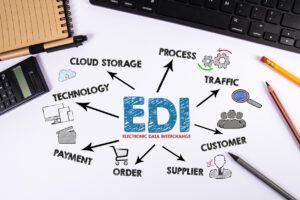 Eliminating manual processes will improve supply chain efficiency, reduce your order-to-cash cycle and increase profits. Integrated Electronic Data Interchange, or EDI, replaces those manual processes and allows organizations to exchange transactional business documents from disparate systems. While EDI has been around for decades, EDI integration challenges are still often encountered. However, without EDI integration, companies struggle to manage their supply chains, from data entry errors to unmet SLAs. In this blog, we’ll take a closer look at some EDI integration challenges and ways to address them so you can reap the benefits of EDI/B2B integration.
Eliminating manual processes will improve supply chain efficiency, reduce your order-to-cash cycle and increase profits. Integrated Electronic Data Interchange, or EDI, replaces those manual processes and allows organizations to exchange transactional business documents from disparate systems. While EDI has been around for decades, EDI integration challenges are still often encountered. However, without EDI integration, companies struggle to manage their supply chains, from data entry errors to unmet SLAs. In this blog, we’ll take a closer look at some EDI integration challenges and ways to address them so you can reap the benefits of EDI/B2B integration.
EDI Integration Challenges
Several obstacles can make the EDI integration process difficult. These challenges include:
1. Standardization Across Internal Systems
The lack of standardization from system to system can impede the exchange of data between different companies or even different departments within the same company. Each system may have its own unique format, data transport method and set of rules that must be followed. This can make it time-consuming and expensive to implement any sort of integration.
2. Lack of Visibility Into the EDI Process and Data
EDI data is often stored in raw EDI form collecting dust in databases, making it difficult to get a holistic view of that data to gain further insights and identify trends, gaps, and opportunities. This leads to overlooked inefficiencies such as revenue leakage stemming from chargebacks. Without being able to see the data and the process flow, it can also be challenging to identify where problems are occurring. Spending precious time resolving issues can ultimately impact the organization’s ability to do business.
3. Incomplete or Missing Data
Data errors can result in delayed order fulfillment, late payments or even lost sales. However, catching and resolving missing or incomplete data errors is often challenging and requires specific skills.
4. Difficulty Integrating EDI With Other Business Applications
EDI can be difficult to integrate with other business applications because it uses a standard data format that may not be compatible with other software. In some cases, all fields required for a particular EDI document do not even exist in some business applications, requiring add-on products, look-up tables or creative translation mapping.
5. High Costs of In-House EDI Implementation and Management
EDI implementation and management can be costly. You’ll need to consider the investment in software licensing (and maintenance fees), hardware, integration and VAN fees. There is also the added expense of hiring and training in-house EDI staff. All told, the cost of an in-house EDI system can quickly add up.
6. Security Issues
With an increase in data breaches in recent years, ensuring an integrated EDI system is protected can present an ongoing challenge. An in-house EDI system may contain sensitive information requiring added layers of protection against unauthorized access.
7. Human Nature and the Aversion to Change
Let’s face it, most companies steer clear of and fear change, especially when the change involves uprooting processes that have been in place and working fine for a long time. Overcoming that fear and remembering that EDI isn’t creating processes from scratch, rather it’s automating existing processes, will get you over that natural aversion.
Overcoming EDI Integration Challenges Through Third-Party Partners
 The above EDI integration challenges can be solved by partnering with a trusted third-party EDI integration provider. They not only have the resources and tools to deliver beneficial solutions, they have the experience, such as the following:
The above EDI integration challenges can be solved by partnering with a trusted third-party EDI integration provider. They not only have the resources and tools to deliver beneficial solutions, they have the experience, such as the following:
- A third-party EDI partner will always adhere to the standards while also accommodating your trading partners’ unique requirements. This will allow you to exchange data with trading partners without the concern of conflicting priorities.
- A third-party EDI solution can provide comprehensive reporting and analytics to overcome the typical lack of visibility which exists in many integration processes today. This will give you the insight into every aspect of the EDI/B2B process, including data flow, transaction volume, exceptions and more.
- EDI integration providers offer secure connections between your systems and your trading partners’ systems, encrypting data in transit and ensuring only authorized users have access.
- Using a third-party partner that specializes in integrating EDI with other business solutions and all sorts of data formats and data transport methods can be an effective strategy. They will ensure that the system properly translates and transports all data between the different systems. They also ensure the quick identification and resolution of errors.
- An EDI service provider offering an all-in-one solution that includes translation, communication and support may be one way to help reduce implementation time and cost, ongoing support costs and future growth costs.
Overcoming Common EDI Integration Challenges with GraceBlood
There are several EDI integration challenges, but partnering with a third-party provider like GraceBlood will set you on the path to overcoming those obstacles. As your trusted EDI partner, GraceBlood can:
- Consult with you to understand both your technology and business needs – one doesn’t work without the other
- Craft a solution that makes the most sense for your organization, based on your unique requirements
- Create a campaign with your current high-volume customers and suppliers to assess the potential benefits (time, money, satisfaction) of implementing EDI between you and them
- Assess current internal applications to determine whether additional data integration opportunities exist
All of these can free-up your valuable time so that you can focus on other aspects of your business. In addition, our solutions are reliable and secure, so you can be confident that your sensitive data remains safe from unauthorized access.
At GraceBlood, we offer EDI and integration solutions that help businesses streamline their operations. For more information on any of our fully customizable solutions, speak to an expert.








